Common to these games is that they are built around coloring, so a (color) dice, some paper, and colored pencils are needed to play them. Although coloring is often associated with children, it's no coincidence that there are many adult coloring books today.
The following games are thus not targeted at children; anyone who likes to play board games, enjoys coloring, and is curious about how these activities can be interconnected is welcome to play.
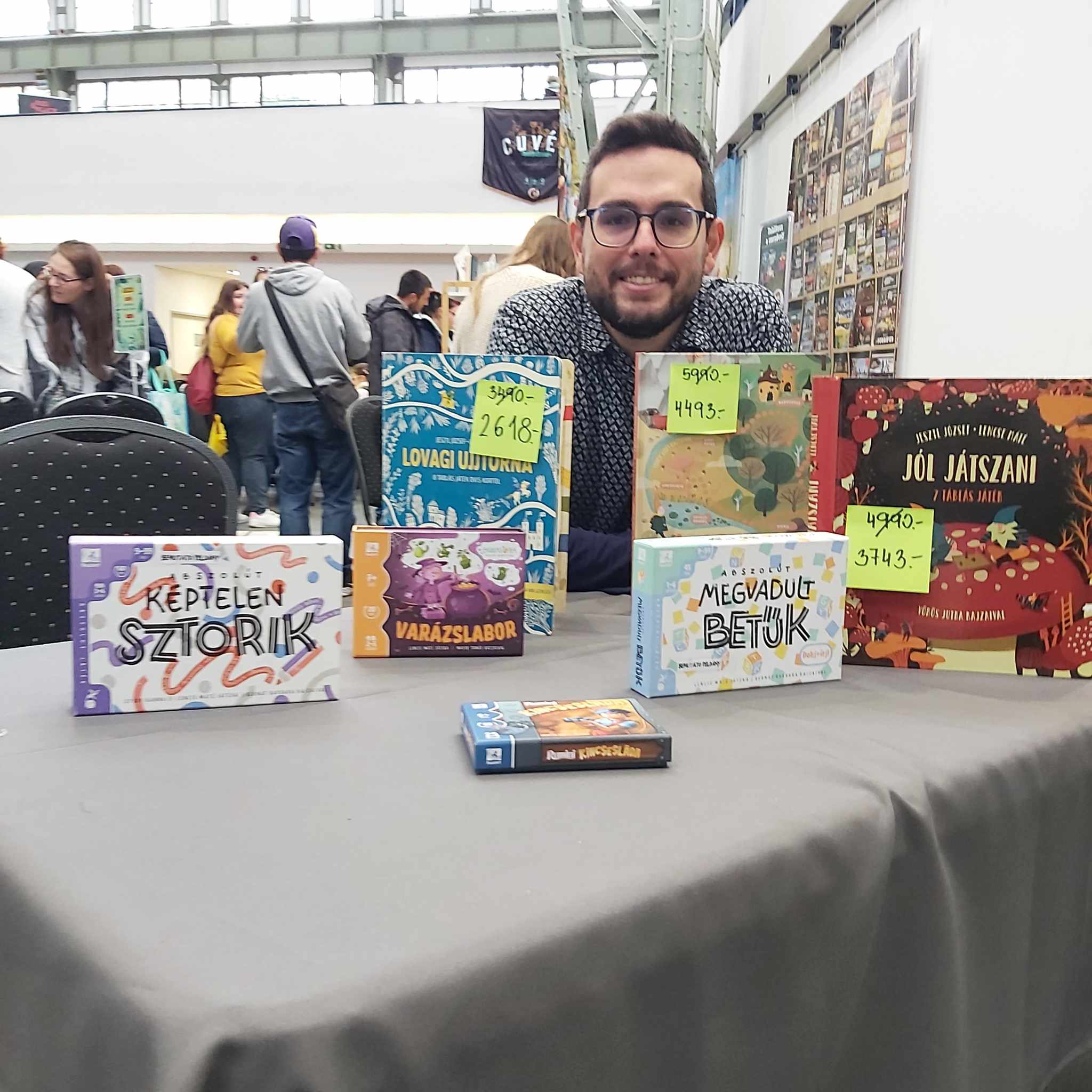
There are plenty of coloring games available online, and the rainbow game category is extremely popular. What we offer here aims to be something more by combining the world of these games with the operation of modern board games.
Roll and Write and Paper and Pencil are popular game mechanics, and their influences will be felt in the board game ideas below. So, these aim to be real board games while still developing color recognition, counting, fine motor skills, and eye-hand coordination, but also greatly stimulate adults' brains, which can be a huge help as they can take us out of our daily activities. Both as an action and as a game.
Coloring board games by Máté
The games are available for free download and can be played, but if you feel inclined to support the game designer, you can do so on their Patreon page - even with just $1.
Click on any of the game names that spark your curiosity to learn all about their details. In between them see my commentary.
What is your favorite animal?
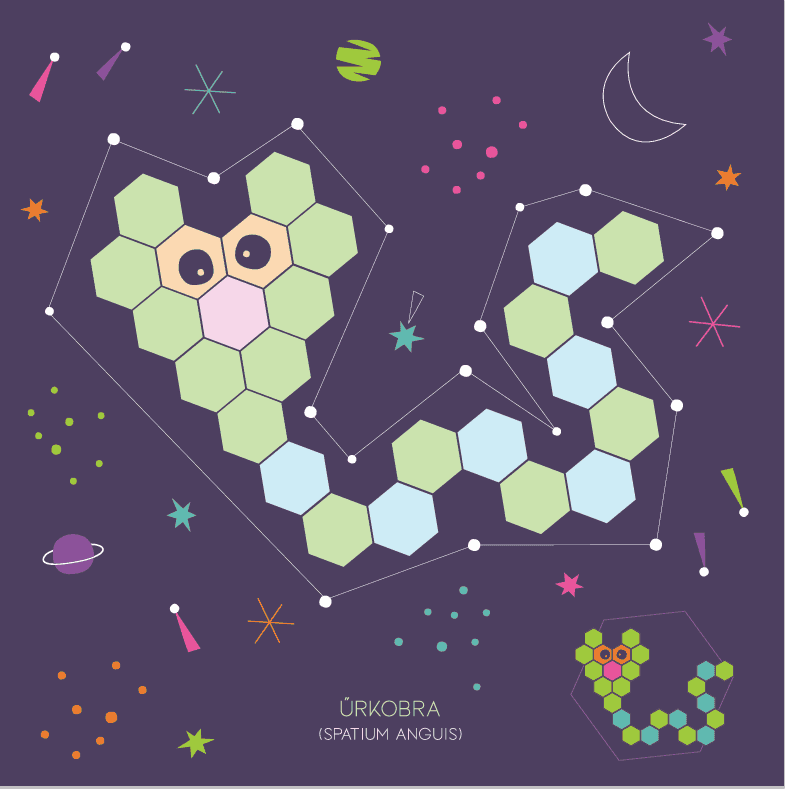
Let's start with a game idea for the little ones. How can we make an enjoyable kindergarten game quickly and for free from almost nothing?
Of course, the theme can be anything, but I find that animals always appeal to children, that's why I chose that. So, you need a coloring page. We can draw this ourselves, or we can search the internet or among existing coloring books. The important thing is that each player has a coloring page and each one consists of the same number of units. The latter is easier to achieve if we make it ourselves. In the original version of the game, each figure consisted of 24 elements. Let me show you an example.
Once the illustrations are ready, color them in lightly with the colors that will be used in the game. This is determined by what color dice we have or what we can make or would like to make. And we also need these colors in the form of pencils or markers.
The goal of the game is for you to be the first to completely color in your picture. The gameplay is very simple. Roll 4 color dice, you can set aside any and re-roll any twice (so in your turn you can roll a maximum of three times in total). After that, choose one of the colors you rolled and color the corresponding area(s) on your picture. So in one round, you can color a maximum of 4 areas and only use one color.
I suggest giving the little ones an advantage where they can exchange two dice of the same color for a color they need. This can come in very handy towards the end of the game.
Well, that's it. This is a simple, soothing, and entertaining game tailored for little ones, but also pleasant for older players. Happy coloring! Have a good game!
(The board game originally appeared in Hungary under the title Lajka, with downloadable rules and sheets, so it's actually playable as well.)
Christmas Tree
For 2-4 players, ages 5 and up, 15 minutes
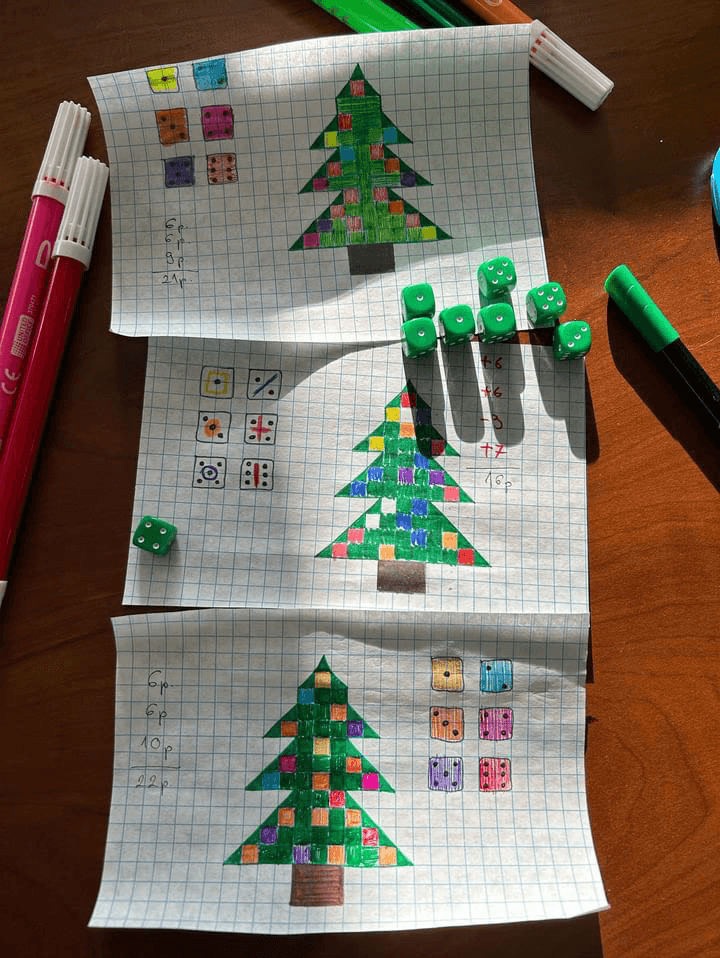
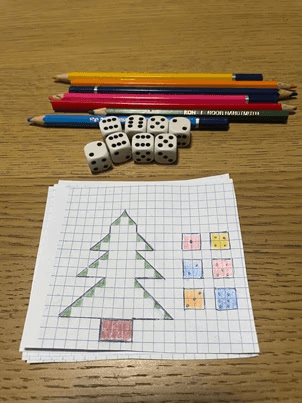
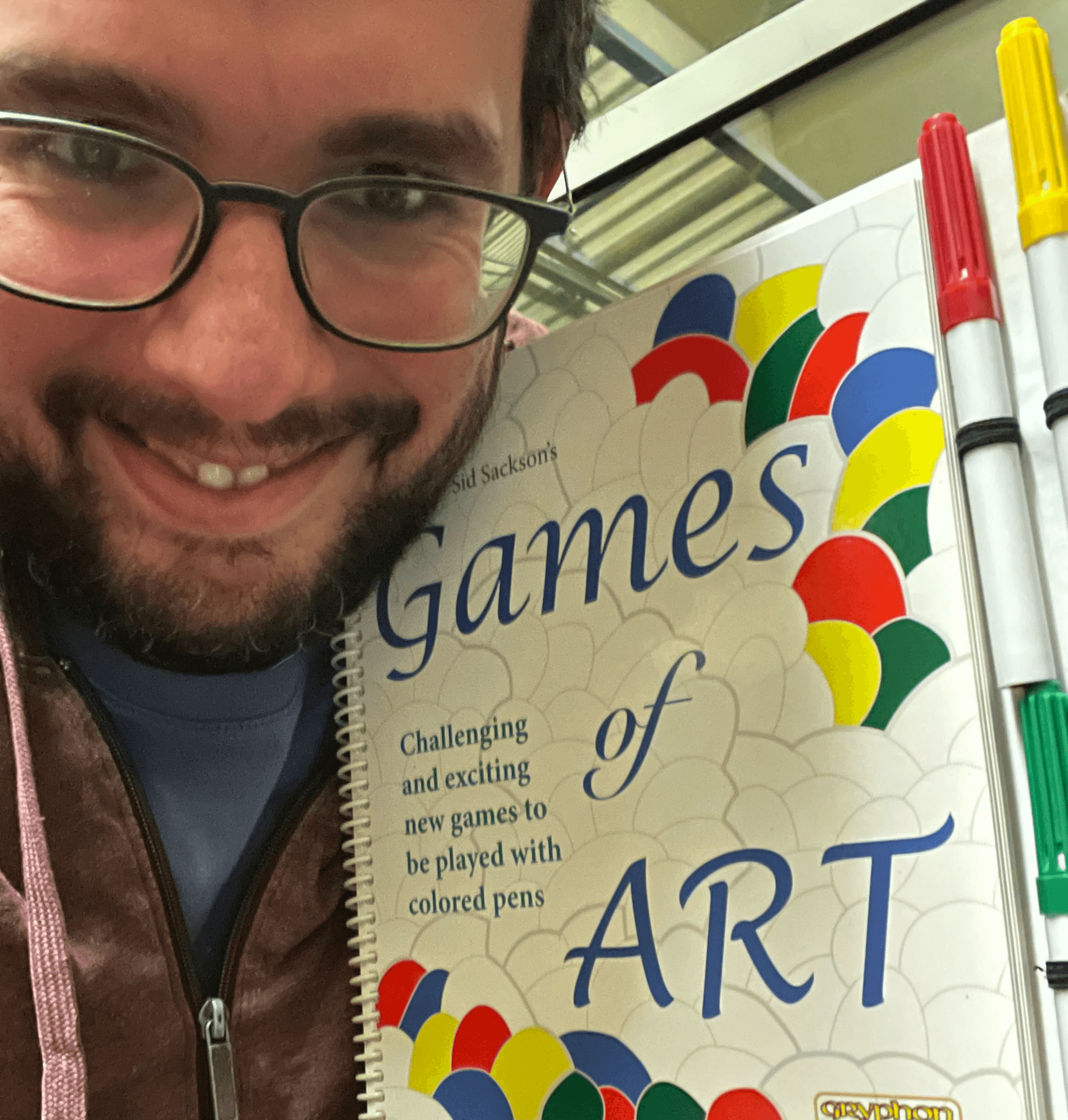
The goal of the game is to decorate the Christmas tree and score as many points as possible.
Everyone gets a tree - you can draw your own or print one from here. If you draw, pre-color the incomplete squares green, which is important to start.
You'll need a green pencil/marker, six additional colors, and eight classic dice. Color the dice indicators next to the tree so that it's clear to everyone which value corresponds to which color.
Choose a starting player who will also take all the dice and roll them. This is how every round begins and continues until all dice are selected. Then, in clockwise order, the next player rolls all the dice, and so on.
The player who rolled always chooses first, then proceed in clockwise order. You can be chosen multiple times in a round.
Dice selection and coloring. In your turn, you can choose one of the following actions: a) take out all the dice of one value, then color that many greens; b) take out one dice and color one ornament with the corresponding color. If there is only one dice left of any value, you can color one green or a specific color.
Notes: a) even if there are multiple dice of one value, you can still take out just one, but then you must color an ornament; b) yes, it's possible for someone to color several times in a round, as we keep choosing dice until there are none left.
Coloring rules: a) ornaments can only be colored in squares that have two green sides, including the pre-colored fields at the start; b) two ornaments cannot be side neighbors, so ornaments do not touch; c) green can be colored in a square that has at least one side neighboring a green field or ornament.
The game ends immediately once someone has colored their entire tree, it does not go through the round.
Scoring: a) points for every used color besides green (max. 6 points); b) extra points for every color besides green appearing at least twice on the tree (max. 6 points); c) points for the most colored ornament, as many times as it appears on the tree; d) minus points for every empty square. The player with the most points wins. In case of a tie, the player with fewer empty squares wins. If still tied, there are multiple winners.
For 2-4 players, ages 5 and up, 15 minutes
The goal of the game is to decorate the Christmas tree and score as many points as possible.
Everyone gets a tree - you can draw your own or print one from here. If you draw, pre-color the incomplete squares green, which is important to start.
You'll need a green pencil/marker, six additional colors, and eight classic dice. Color the dice indicators next to the tree so that it's clear to everyone which value corresponds to which color.
Choose a starting player who will also take all the dice and roll them. This is how every round begins and continues until all dice are selected. Then, in clockwise order, the next player rolls all the dice, and so on.
The player who rolled always chooses first, then proceed in clockwise order. You can be chosen multiple times in a round.
Dice selection and coloring. In your turn, you can choose one of the following actions: a) take out all the dice of one value, then color that many greens; b) take out one dice and color one ornament with the corresponding color. If there is only one dice left of any value, you can color one green or a specific color.
Notes: a) even if there are multiple dice of one value, you can still take out just one, but then you must color an ornament; b) yes, it's possible for someone to color several times in a round, as we keep choosing dice until there are none left.
Coloring rules: a) ornaments can only be colored in squares that have two green sides, including the pre-colored fields at the start; b) two ornaments cannot be side neighbors, so ornaments do not touch; c) green can be colored in a square that has at least one side neighboring a green field or ornament.
The game ends immediately once someone has colored their entire tree, it does not go through the round.
Scoring: a) points for every used color besides green (max. 6 points); b) extra points for every color besides green appearing at least twice on the tree (max. 6 points); c) points for the most colored ornament, as many times as it appears on the tree; d) minus points for every empty square. The player with the most points wins. In case of a tie, the player with fewer empty squares wins. If still tied, there are multiple winners.
Easter Egg Painting
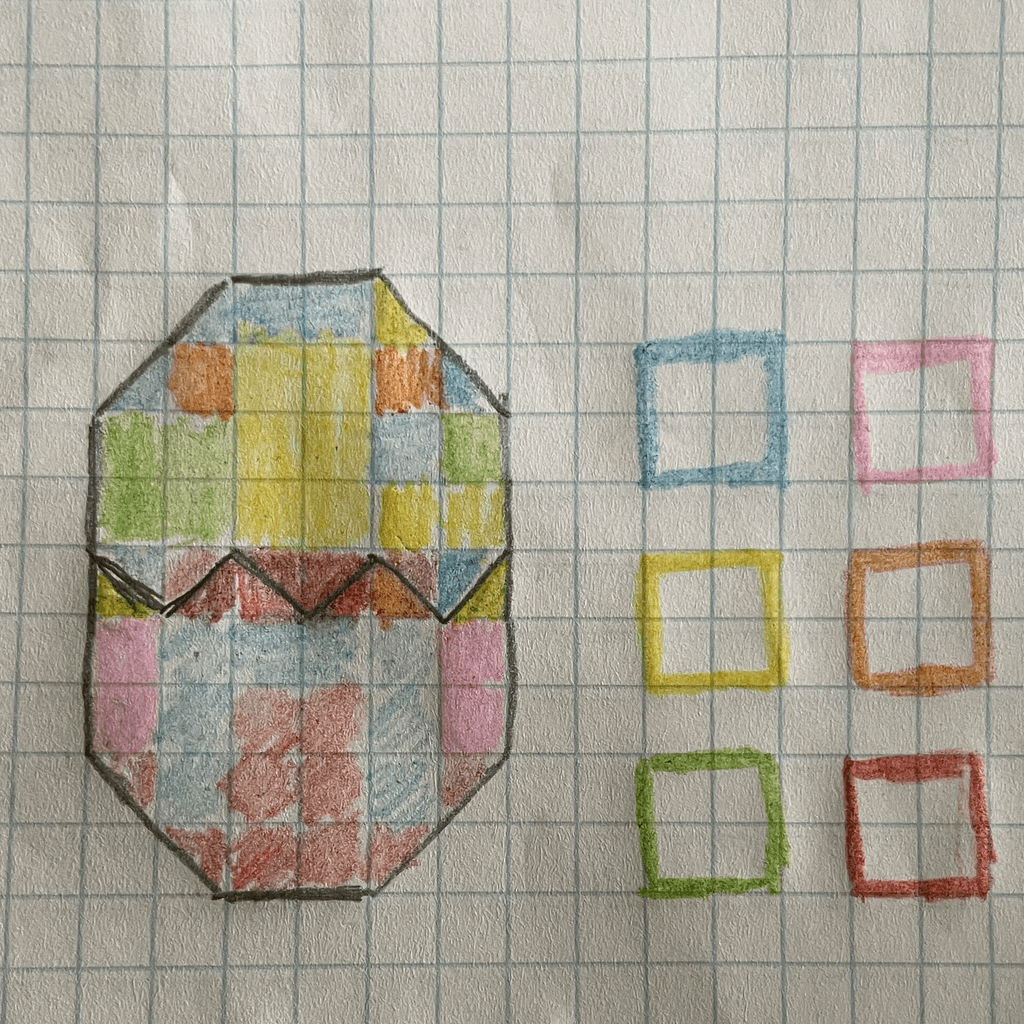
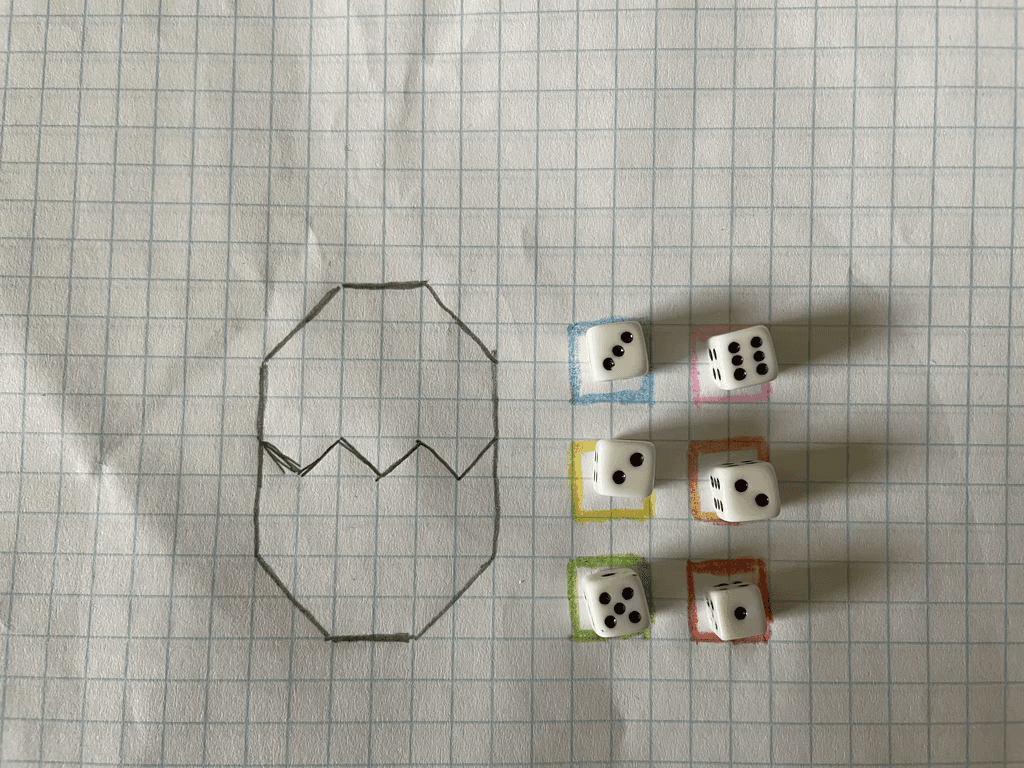
For 2-3 players, ages 6 and up, 15 minutes.
The game's components are very simple. You need six classic dice, draw as many eggs on a grid paper notebook as there are players, based on the pattern below. You also need six colored pencils or markers, with them draw 6 squares, one for each color, large enough to fit a die. This will be the dice selection area, one is enough, there's no need for each player to have their own.
The gameplay. The player whose turn it is rolls all the dice and places them in the colored frames as they wish. Then, they choose a die first, and subsequently, the other players each pick one in a clockwise direction. Thus, in a round, players take turns multiple times and choose from the remaining dice.
The coloring rules. You must color in as many spaces as the die shows, and the color must match the frame from which you selected the die. A full square counts as one space, and half of a divided square also counts as one space. In a round, you can either color full squares or half squares, but not both.
Scoring. The game ends in the round when someone has colored in their entire egg. At this point, ensure that everyone has had an equal number of turns, with the same number of dice selections and coloring opportunities. Then you can start scoring. First, look at the half squares and establish an order based on which color has the most, second most, and third most. In the event of a tie, you decide which comes first. Then, count the full squares for these colors. The most valuable color will be the one with the most half squares, with each full square of this color worth 3 points, the second most valuable color worth 2 points per full square, and the third 1 point per full square. The player with the most points wins; in case of a tie, there are multiple winners.
(The colored egg above is worth 48 points because red was the most valuable color, with 6 collected making 18 points, the 11 blue ones worth 22 points, and the 8 yellow ones 8 points.)
Valentine's Day - Date Night
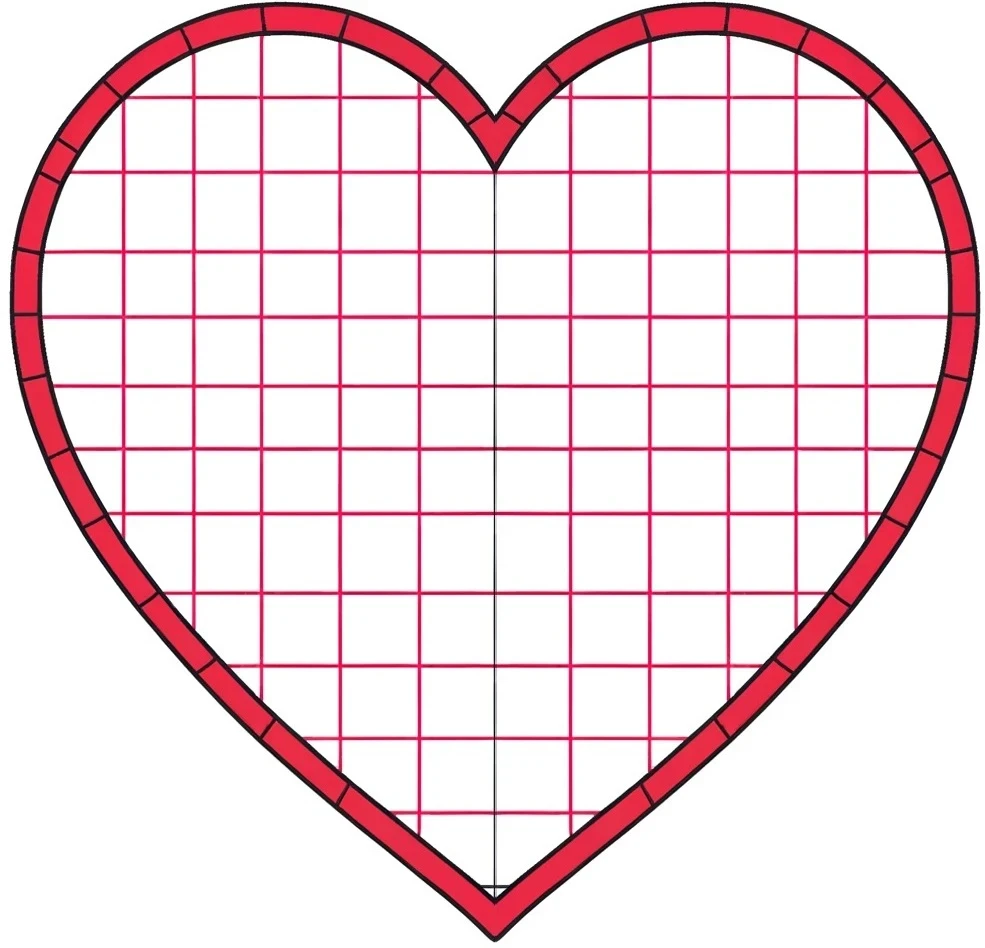
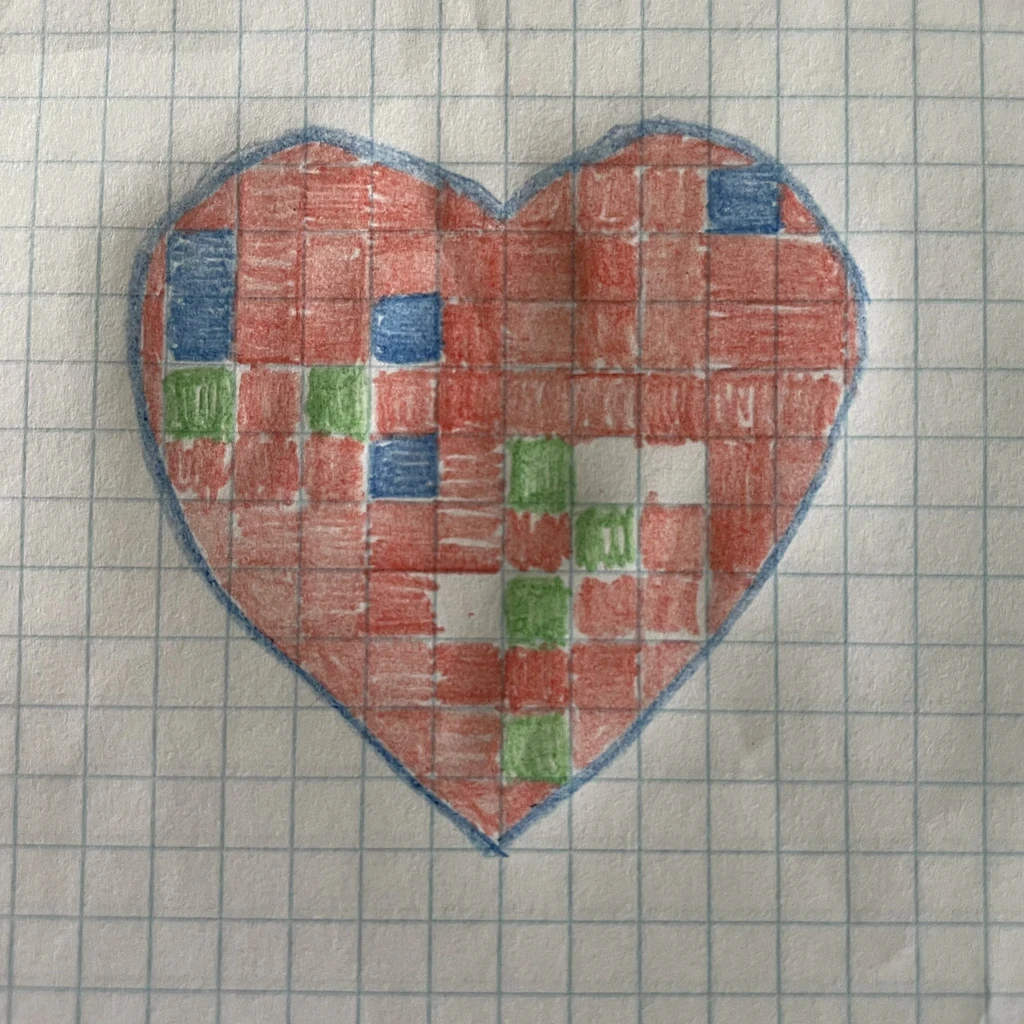
(Any weekday can be turned into a Valentine's Day evening if we want!)
For 2-4 players, ages 14 and up, 30 minutes
The goal of the game is to color this heart together. (If you can't print, you can also draw, for which you just need a squared notebook.) To succeed, you must show how well you know each other.
For the game, you will need a classic dice, the printed or drawn heart, a red pencil, and one pencil each of your favorite color. If one of you has red as their favorite color or if you both have the same favorite, then someone should choose their second favorite from their list, because the game requires three different colors.
To start, color the incomplete quadrilaterals with red and discuss who will go first.
The number of rounds in the game depends on how long you have been together. If it's less than 1 year, then 12 rounds; if 1-3 years, then 11 rounds; if 3-7 years, then 10 rounds; if more than 7 years, then you must complete the task within 9 rounds. You can use anything to count the rounds.
Each round consists of one turn for each of the two players. The player whose turn it is rolls their dice, and their partner then determines the topic based on the rolled value, which always pertains to themselves. The topics can be lighter— what are my favorite movies? — or deeper — what were the hardest moments for me in our relationship? The key is that the player who rolled the dice must give a correct number of answers corresponding to the rolled value.
Your favorite colors are used as follows: In each round, there are two opportunities to color above the rolled value. For every correct answer given, you can color the same number of quadrilaterals in red. If this was the maximum performance, meaning three correct answers for a roll of three, one for a roll of one, then you can also color an additional quadrilateral in your own favorite color. Moreover, in each round, you can take a risk once. If you are confident, try to say the first answer simultaneously. If you succeed, then at the end of the round, the player who rolled the dice can color an extra quadrilateral in their favorite color. If not successful, the round ends immediately, and any remaining answers — even if possible — are not attempted.
If you manage to finish coloring the heart by the latest, the last round, then you are a wonderful couple. If not, you still are, but in the following days, go on dates for as many hours as there are quadrilaterals left uncolored.
The games are available for free download and can be played, but if you feel inclined to support the game designer, you can do so on their Patreon page - even with just $1.
Car Racing
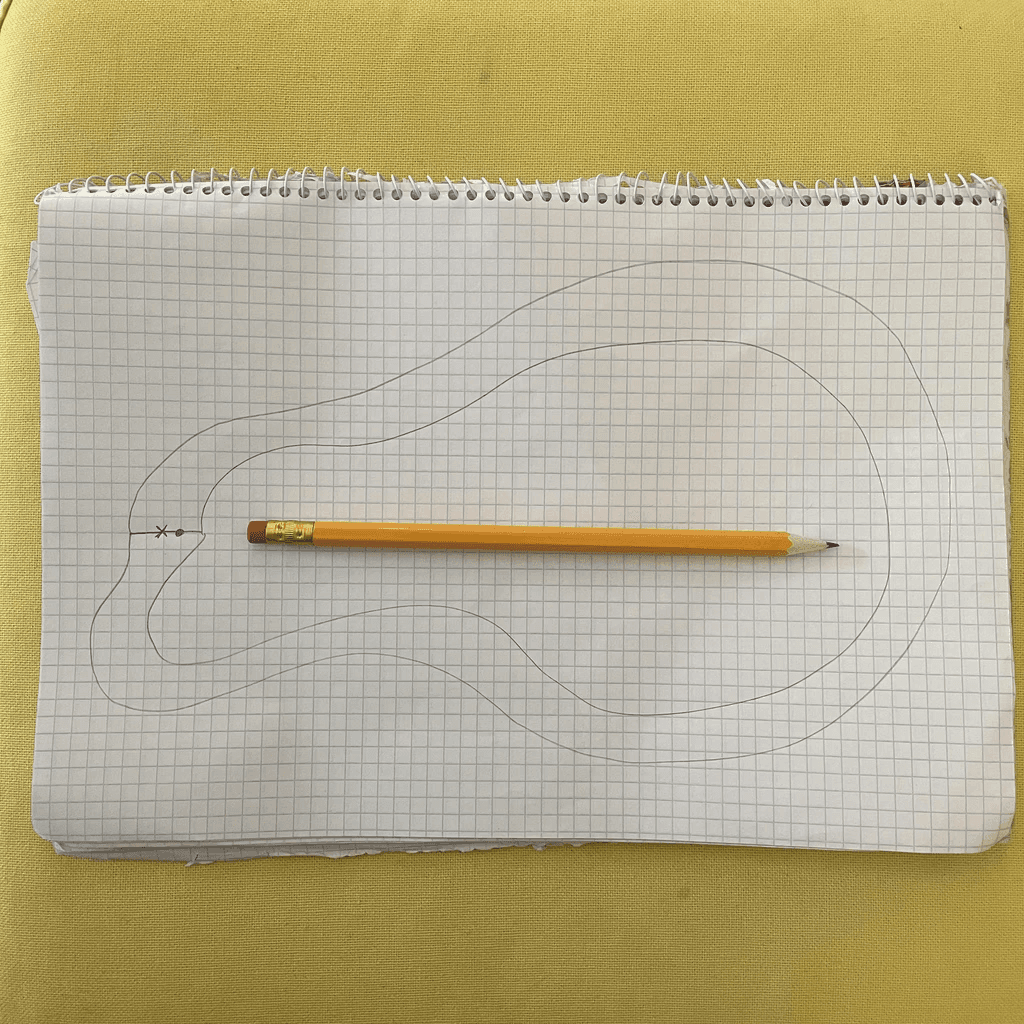
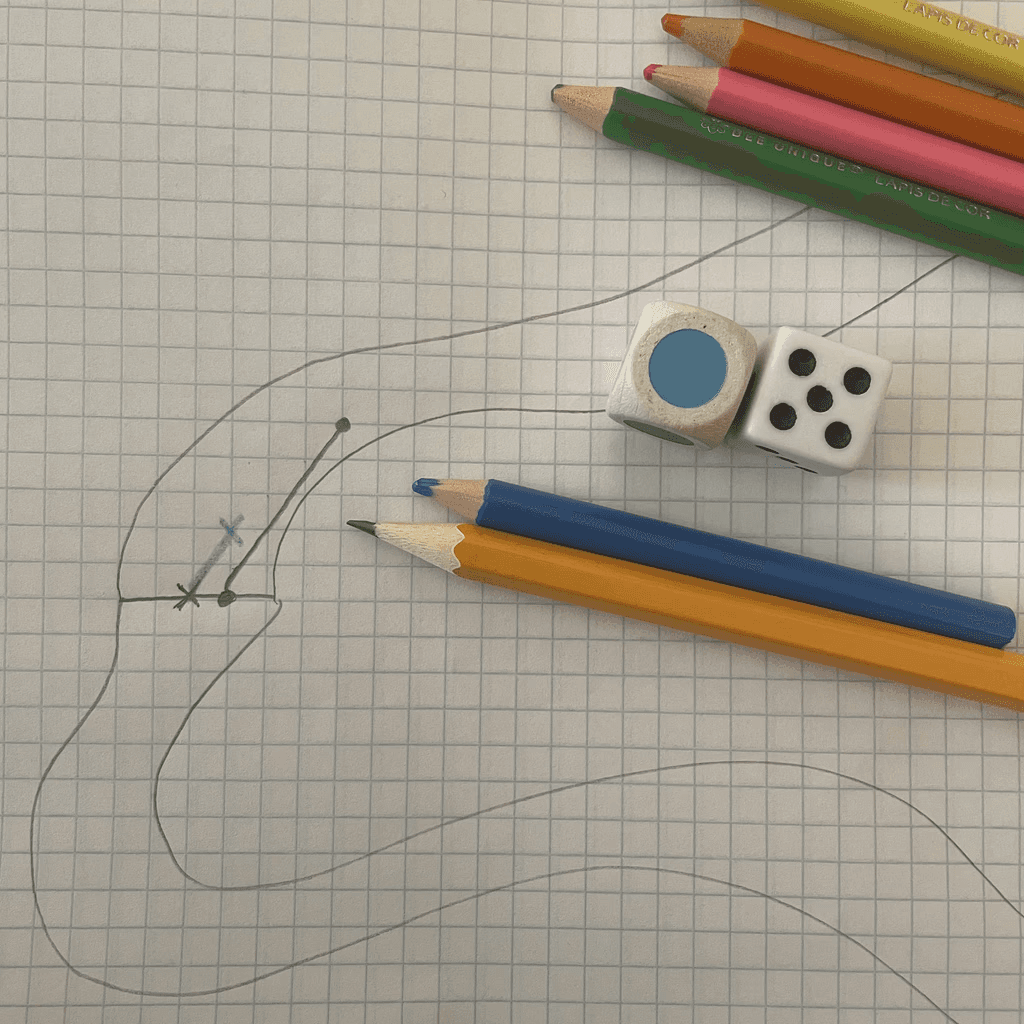
For 2 players, ages 5 and up, 10 minutes
The goal is to collect as many points as possible. Decide who will be with the circle and who will be with the cross.
You will need 6 colored pencils, 1 graphite pencil, a grid notebook, a classic die, and a color die. The latter may not be available in every household, but you can stick colored dots on a regular die or simply agree on what colors the rolled values correspond to. You will need to draw a racetrack in the notebook with a start-finish line.
Players take turns. In their turn, a player rolls both dice and then decides on their move. If they move based on the traditional die, they simply move the rolled value and mark the path with graphite. If they move based on the color die, they must round down and halve the rolled value, and mark the path with the rolled color. So, if I roll a five and blue, then I can move two steps with blue. Remember, we always mark our moves with dots and crosses.
Step rules. After the roll, the chosen number of steps represents squares, from grid point to grid point. You must be able to connect the grid points with a straight line without going off the track, not even touching the edge of the track, and you cannot pass through the opponent's most recently marked grid point.
You must complete all the steps of the chosen action; if this is not possible, then you cannot move during your turn.
The game ends when both players have finished.
Scoring. The player who reaches the goal first gets 3 points. Then, examine who has the majority in colors. Excluding graphite, examine each color separately: how many steps each player has taken with the colors throughout the entire race. Each color majority is worth 2 points. If there is a tie in any color, then no one gets points. The player with the most points wins.